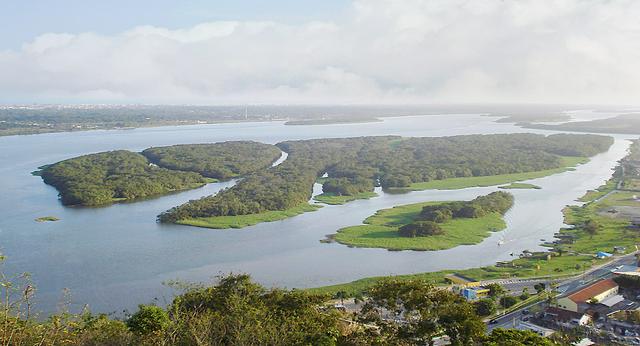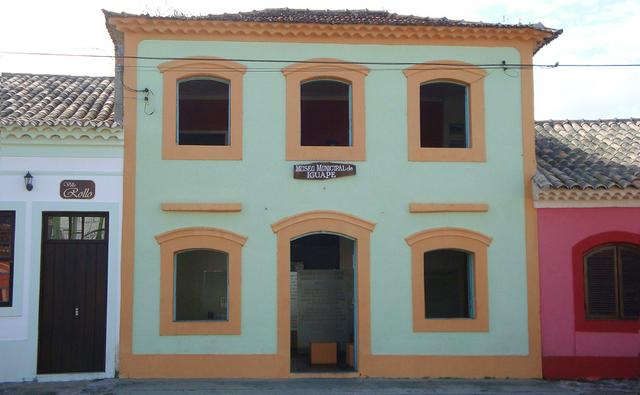Iguape is a small city in the South Coast of São Paulo state. Iguape is a town from the colonial period that combines beautiful natural surroundings with a charming historic center, a national heritage site. If you do not have plans to visit the most famous Brazilian Colonial cities (such as Ouro Preto or Olinda), then Iguape is certainly worth a visit.

It is speculated that the Spanish settlement in Iguape may have started in 1498, before the Portuguese arrived in Brazil in 1500. Iguape was founded as a city in 1538 after a bloody fight between the Portuguese government and rogue aristocrats.
Iguape remained a quiet place for a long time, until the 19th century, when rice farming brought an economic boom to the city. Many historical constructions in the city are originals from this period. However, with the failure of an attempt to construct a canal for ships in the city, Iguape's economy declined in the early 20th century. For this reason, Iguape is now a small city with an economy based on fishing and tourism.
Iguape's city center contains several constructions from the 17th-19th centuries. The city contains the largest colonial heritage of São Paulo state. As a relatively poor city, Iguape relies on state and federal help to maintain its heritage.

- Basílica do Senhor Bom Jesus de Iguape, Praça da Basílica, 114 - Centro, +55 13 3841-1131. The city's main church, a Colonial-style church inaugurated in 1856, took 69 years to be built due the city's many economical struggles. The churches has paintings by Ernesto Thomazini.
- Casa de Fundição, Rua das Neves, 45 - Centro, +55 13 3841-3012. M-F 10:00-12:00, 14:00-18:00. One of Brazil's three oldest foundries, likely founded in the 1650s and used to make gold coins. It is now a museum dedicated to the history of the city.
- Museu de Arte Sacra, Rua Papa João XXIII - Centro, +55 13 3841-3012. M-F 10:00-12:00, 14:00-18:00. Colonial church built in the 17th century as a place of prayer for African slaves. Now it is a holy art museum with about 150 pieces.
- Rua do Funil, Rua das Neves - Centro. "Rua do Funil" is a nickname for the Rua das Neves, which has the shape of a funnel when seen of above. It is one of the most picturesque spots of the city, with a large collection of Colonial buildings.
- Museum of History, R. das Neves, 33 - Centro, CEP 11920-000.
Basílica do Senhor Bom Jesus de Iguape, Praça da Basílica, 114 - Centro, +55 13 3841-1131. The city's main church, a Colonial-style church inaugurated in 1856, took 69 years to be built due the city's many economical struggles. The churches has paintings by Ernesto Thomazini.
Casa de Fundição, Rua das Neves, 45 - Centro, +55 13 3841-3012. M-F 10:00-12:00, 14:00-18:00. One of Brazil's three oldest foundries, likely founded in the 1650s and used to make gold coins. It is now a museum dedicated to the history of the city.
Museu de Arte Sacra, Rua Papa João XXIII - Centro, +55 13 3841-3012. M-F 10:00-12:00, 14:00-18:00. Colonial church built in the 17th century as a place of prayer for African slaves. Now it is a holy art museum with about 150 pieces.
Rua do Funil, Rua das Neves - Centro. "Rua do Funil" is a nickname for the Rua das Neves, which has the shape of a funnel when seen of above. It is one of the most picturesque spots of the city, with a large collection of Colonial buildings.
Museum of History, R. das Neves, 33 - Centro, CEP 11920-000.
- Christ the Redeemer statue, +55 13 3848-6800. This is worth going to if you are in the area. The statue and viewpoint are in a park in an elevated area, that provides an excellent panoramic view of the city and the surrounding nature. This statue is significantly smaller than the famous one in Rio, but is on a cliff side giving a good view of the small town and the ocean.
- Juréia beach. Surrounded by Atlantic rainforest, the long and unspoiled Juréia beach can be accessed by taking a ferry boat.
Christ the Redeemer statue, +55 13 3848-6800. This is worth going to if you are in the area. The statue and viewpoint are in a park in an elevated area, that provides an excellent panoramic view of the city and the surrounding nature. This statue is significantly smaller than the famous one in Rio, but is on a cliff side giving a good view of the small town and the ocean.
Juréia beach. Surrounded by Atlantic rainforest, the long and unspoiled Juréia beach can be accessed by taking a ferry boat.
- Ilha Comprida - The island just next to Iguape boasts an enormous beach, well-preserved nature and an area with sand dunes
- Jacupiranga Conservation Units - Previously called "Jacupiranga State Park", it contains a large original Atlantic rainforest reserve, the famous "Caverna do Diabo" (Devil's Cave) and the beautiful Lagamar de Cananéia
- Alto Ribeira State Touristic Park - One of the largest original Atlantic rainforest reserves of the country, hence with large animal biodiversity, also with the highest concentration of caves in the World
- Cananéia - A nice historic center and access to the unspoiled Cardoso island
